Hand grenade data. Models marked "*" are obsolete as of 2000.
| Model |
Type |
Body |
Filler |
Fuze |
Weight |
Throwing Range |
Effect |
| ABC-M7A2 |
riot control |
sheet metal cylinder |
5.5 oz (156 g) of burning mixture and 3.5 oz (99 g) of CS in gelatin capsules |
M201A1, M201A1 MOD2 |
15.5 oz (439 g) |
131 ft (40 m) |
Cloud of irritant agent for 15 to 35 seconds |
| ABC-M7A3 |
riot control |
sheet metal cylinder |
7.5 oz (213 g) of burning mixture and 4.5 oz (128 g) of pelletized CS agent |
M201A1, M201A1 MOD2 |
15.5 oz (439 g) |
131 ft (40 m) |
Cloud of irritant agent for 15 to 35 seconds |
| ABC-M25A1*, ABC-M25A2* |
riot control |
compressed fiber or plastic sphere |
CS1 or CN1 mixed with silica aerogel |
C12 |
7.5 to 8 oz (213 to 227 g) |
164 ft (50 m) |
Bursting radius: 16 ft (5 m) |
| AN-M8 |
white smoke |
sheet steel cylinder |
19 oz (539 g) of Type C, HC smoke mixture |
M201A1 |
24 oz (680 g) |
100 ft (30 m) |
Emits a dense cloud of white smoke for 105 to 150 seconds |
| AN-M14 |
incendiary |
sheet metal cylinder |
26.5 oz (751 g) of thermate (TH3) mixture |
M201A1 |
32 oz (907 g) |
82 ft (25 m) |
Can burn through 1/2 in (12.7 mm) steel plate |
| AN-M83 |
white smoke |
2.5 in (64 mm) diameter, 5.7 in (145 mm) long, thin sheet metal cylinder |
11 oz (312 g) of terephthalic acid (TA) |
M201A1 |
16 oz (454 g) |
? |
Cloud of white smoke for 25 to 70 seconds |
| GG04 |
non-lethal |
3.12 in (79 mm) diameter rubber sphere |
100 .25 in (6.4 mm) hard rubber pellets |
M201A1-1 |
10.2 oz (290 g) |
50 ft (15 m) |
Max range: 50 ft (15 m). Effective range: 6 to 10 ft (2 to 3 m) |
| GG05 |
practice |
3.12 in (79 mm) diameter rubber sphere |
N/A |
M201A1-1 |
7.3 oz (208 g) |
50 ft (15 m) |
N/A |
| M15 |
smoke |
sheet metal |
15 oz (425 g) of white phosphorus (WP) |
M206A2 |
31 oz (879 g) |
100 ft (30 m) |
Bursting radius: 56 ft (17 m)
Burn time: 60 seconds |
| M18 |
colored smoke |
sheet steel cylinder |
11.5 oz (326 g) of colored smoke mixture (red, yellow, green, or violet) |
M201A1 |
19 oz (538 g) |
115 ft (35 m) |
Cloud of colored smoke for 50 to 90 seconds with average burn time of 60 seconds |
| M26*, M26A1* |
frag |
cast iron |
flaked or granular TNT |
M204A1 or M204A2 |
21 oz (595 g) |
131 ft (40 m) |
Casualty radius: 50 ft (15 m) |
| M47 |
riot control |
3.5 in (89 mm) diameter rubber sphere |
6.5 oz (185 g) of CS pyrotechnics granulated mix |
M227 |
14.5 oz (410 g) |
115 to 150 ft (35 to 45 m) |
1,615 ft² (150 m²) of irritant agent
Burn time: 8 to 20 seconds |
| M61 |
frag |
thin sheet metal |
5.5 oz (156 g) of Composition B HE |
M204A1 or M204A2 |
16 oz (454 g) |
131 ft (40 m) |
Casualty radius: 50 ft (15 m)
Kill radius: 16 ft (5 m) |
| M67 |
frag |
2.5 in (64 mm) steel sphere with a scored steel spring for fragmentation |
6.5 oz (184 g) of Composition B HE |
M213 |
14 oz
(397 g) |
115 ft
(35 m) |
Casualty radius: 50 ft (15 m)
Kill radius: 16 ft (5 m) |
| M69 |
practice |
steel sphere |
N/A |
M228 |
14 oz (397 g) |
131 ft (40 m) |
Emits a small puff of white smoke |
| M83 |
training |
? |
16 oz (454 g) of smoke mixture |
? |
? |
? |
? |
| M84 |
non-lethal |
5.25 in (133 mm) long, steel hexagon tube |
? |
M201A1, M201A1 MOD2 |
13.3 oz (377 g) |
? |
Emits intense light and sound |
| MK2* |
frag |
cast iron |
flaked or granular TNT |
M204A1 or M204A2 |
21 oz (595 g) |
100 ft (30 m) |
Bursting radius: 33 ft (10 m) |
| MK3A2 |
offensive |
fiberglass cylinder |
8 oz (227 g) of TNT |
M206A1 or M206A2 |
15.6 oz (442 g) |
131 ft (40 m) |
Casualty radius: 7 ft (2 m) |
| No. 5 Mark I Mills* |
frag |
cast iron |
? |
seperate igniter |
22.5 oz (638 g) |
at least 90 ft (27 m) |
? |
| XM102 |
training |
steel hexagon tube |
? |
? |
? |
? |
? |
Grenade, Hand, Riot, CS, ABC-M7A2
Grenade, Hand, Riot, CS, ABC-M7A3
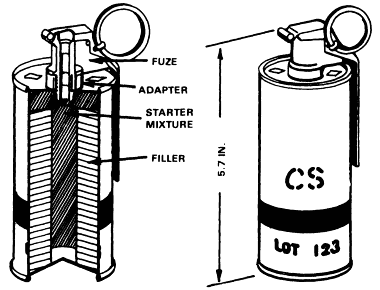
The ABC-M7A2 and ABC-M7A3 riot-control hand grenades contain only CS as a filler. They differ only in the amount of filler and the
form of the CS they contain. The ABC-M7A2 grenade has 5.5 ounces of burning mixture and 3.5 ounces of CS in gelatin
capsules. The ABC-M7A3 has 7.5 ounces of burning mixture and 4.5 ounces of CS pellets.
The bodies of both grenades are sheet metal with four emission holes at the top and one at the bottom. Both grenades have gray bodies
with red bands and markings. These grenades do not have safety clips.
ABC-M7A3 Unit cost: $175 (Fiscal Year 2005).
Grenade, Hand, Riot, CN1, ABC-M25A1

Obsolete. The ABC-M25A1 riot control hand grenade is a bursting munition with an integral fuze.
All fillers are mixed with silica aerogel for increased dissemination efficiency.
The M25 series of riot-control hand grenades have a radius burst (visible cloud grenade) of about 16 feet (5 m),
but fragments of the grenade are occasionally projected up to 82 feet (25 m).
The grenade has a gray body with red band and red markings.
Grenade, Hand, Riot, CN1, ABC-M25A2
Grenade, Hand, Riot, CS1, ABC-M25A2
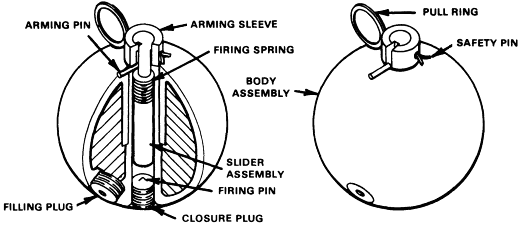
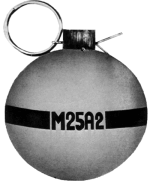
ABC-M25A2 CS1
Obsolete. The ABC-M25A2 riot control hand grenade is a bursting munition with an integral fuze. The M25A2 grenade is an improved version of
the M25A1 grenade. The two grenades differ primarily in body construction.
All fillers are mixed with silica aerogel for increased dissemination efficiency.
The M25 series of riot-control hand grenades have a radius burst (visible cloud grenade) of about 16 feet (5 m),
but fragments of the grenade are occasionally projected up to 82 feet (25 m).
The grenade has a gray body with red band and red markings.
Grenade, Hand, Smoke, HC, AN-M8
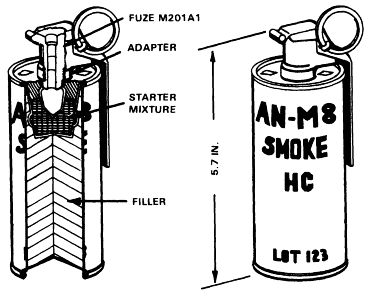
The AN-M8 HC grenade is used to produce dense clouds of white smoke for signaling and screening. Note that this
grenade was listed as obsolete in the September 2000 FM 3-23.30, while the latest June 2005 release of the manual
lists the grenade as currently in service.
WARNING: The AN-M8 HC grenade produces harmful hydrochloric fumes that irritate the eyes, throat, and lungs.
It should not be used in closed-in areas unless soldiers are wearing protective masks.
WARNING: Damaged AN-M8 HC grenades that expose the filler are hazardous. Exposure of the filler to moisture and
air could result in a chemical reaction that will ignite the grenade.
The grenade has a light green body with black markings and a white top.
Grenade, Hand, Incendiary, TH3, AN-M14
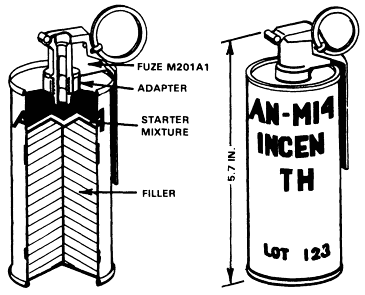
The AN-M14 TH3 incendiary hand grenade is used to destroy equipment or start fires. It can also damage, immobilize, or destroy
vehicles, weapons systems, shelters, or munitions.
A portion of thermate mixture is converted to molten iron, which burns at 4,000° Fahrenheit. The mixture fuzes together the
metallic parts of any object that it contacts. Thermate is an improved version of thermite, the incendiary agent used in hand
grenades during World War II. The thermate filler can burn through a 1/2-inch homogenous steel plate. It produces its own oxygen
and burns under water.
WARNING: Avoid looking directly at the incendiary hand grenade as it burns. The intensity of the light is hazardous to the retina
and can cause permanent eye damage.
The grenade is gray in color with purple markings and a single purple band (current grenades). Under the standard color-coding
system, incendiary grenades are light red with black markings. This grenade does not have a safety clip.
Grenade, Hand, White Smoke, TA, AN-M83

The AN-M83 TA white smoke hand grenade is used for screening the activities of small units and for ground-to-air signaling.
The grenade has a forest green body with light green markings, a blue band, and a white top.
Grenade, Hand, Rubber Ball, Non-Lethal, GG04
The GG04 rubber ball grenade is used in crowd control situations where the use of non-lethal force is desired.
The rubber ball grenade is designed to be hand-thrown or muzzle-launched from a 12-gauge shotgun.
The GG04 is a multiple projectile, flash-bang grenade with 100 .25-caliber hard rubber pellets. The grenade has a
fuze delay of 2.8 to 3 seconds with a flash measuring approximately 1 million CP and 180 decibels at 3.5 feet.
At detonation, rubber pellets are dispatched at 360° with an effective range of 2 to 3 meters and a maximum
engagement range of 15 to 20 meters.
The grenade body is a rubber sphere that contains a fuze well liner.
The grenade is black with white lettering.
Fielded: 1998. Unit cost: $30 (Marine Corps Fiscal Year 2003).
Grenade, Hand, Practice, Non-Lethal, GG05
The GG05 is designed to replicate the live GG04 rubber ball grenade. It is made of durable rubber and can be
hand-thrown or muzzle-launched from the 12-gauge shotgun. The body can be reloaded up to 25 times and is a
component of a practice grenade assembly, consisting of the body and a M201A1-1 practice grenade fuze.
The grenade body is a rubber sphere that contains a fuze well liner and is filled with .50 caliber rubber
pellets. The rubber ball pellets remain within the body.
The GG05 is blue in color. The fuze has a blue safety lever with a brown stripe.
This is a training unique item; not used in combat.
Fielded: 2002. Unit cost: $11 (Marine Corps Fiscal Year 2003).
Grenade, Hand, Smoke, WP, M15
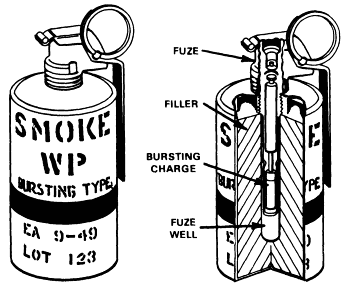
The M15 white phosphorous grenade is a bursting type grenade used for signaling, screening, and incendiary purposes.
WARNING: All friendly personnel within the 56 foot (17 m) bursting radius should be in a covered position to avoid being struck by
burning particles. The WP filler burns for about 60 seconds at a temperature of 5,000° Fahrenheit. This intense heat causes the
smoke produced by the grenade to rise quite rapidly, especially in cool climates. This makes the M15 grenade less desirable for use
as a screening agent.
The grenade is grey with one yellow band and yellow markings.
Grenade, Hand, Smoke, Green, M18
Grenade, Hand, Smoke, Yellow, M18
Grenade, Hand, Smoke, Violet, M18
Grenade, Hand, Smoke, Red, M18

The M18 colored smoke hand grenade is used for ground-to-air or ground-to-ground signaling.
The body consists of a sheet steel cylinder with emission holes:
- Four emission holes at the top and one at the bottom (older production).
- Four emission holes at the top and none at the bottom (more recent production).
- No top emission holes and one taped bottom hole (current and recent production).
The holes allow smoke to escape when the grenade is ignited.
WARNING: Burning type grenades burn oxygen. Standard protective masks filter particles but will not
supply oxygen. Therefore, burning grenades should not be used in enclosed or confined spaces.
The M18 grenade is light green with black markings. The top of the grenade indicates the smoke color
(red, yellow, green, or violet).
Yellow smoke is sometimes difficult to see in urban areas. Newer versions of yellow smoke grenades are more visible than the old type.
The body contains a primer, first fire mixture, pyrotechnic delay column, and ignition mixture. Assembled to the body are a striker,
striker spring, safety lever, and safety pin with pull ring. The split end of the safety pin has an angular spread.
This is a training standard item used in both training and combat.
Type Classification Date: Early 1950's. Unit cost: $43.20 (Fiscal Year 2005).
Grenade, Hand, Fragmentation, M26
Grenade, Hand, Fragmentation, M26A1
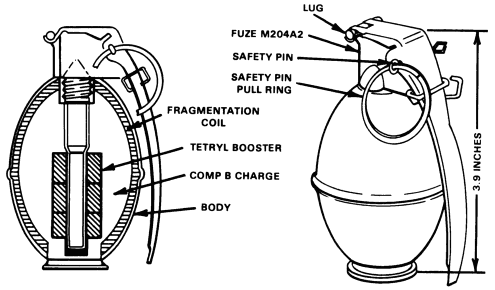
Obsolete. These grenades are used to supplement small arms fire against an enemy in close combat. They produce casualties through
the high-velocity projection of fragments.
The M26 and M26A1 fragmentation grenades have been reclassified as the M61 under the product improvement program that added an
attached safety clip feature.
WARNING: Although the casualty-producing radius is 50 feet (15 m), fragmentation can disperse as far away as 755 feet (230 m).
These grenades have an olive drab body with a single yellow band at the top and yellow markings, which indicate a high-explosive filler.
Grenade, Hand, Riot, CS, M47
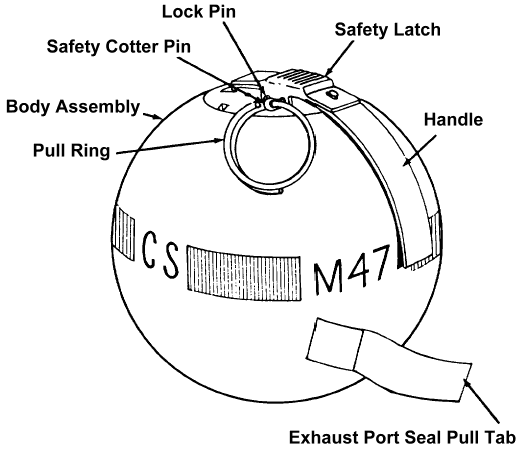
The M47 grenade is a special-purpose, burning type munition used for the control of riots and counterinsurgencies.
This grenade is a nonlethal, incapacitating type munition that contains non-persistent CS agent.
The M47 consists of a rubber body assembly with a fuse delay of about 2 to 3 seconds before ignition. Discharge of
the CS results in a random "skittering" of the grenade. The speed of the discharge through the ports
prevents target personnel from picking up the grenade and throwing it back. The manner in which this grenade explodes
also eliminates fragmentation side effects and minimizes fire hazards.
The top half of the grenade contains the fuze, and bottom half contains the filling hole and exhaust port.
Gray with red band and black markings.
Grenade, Hand, Fragmentation, M61
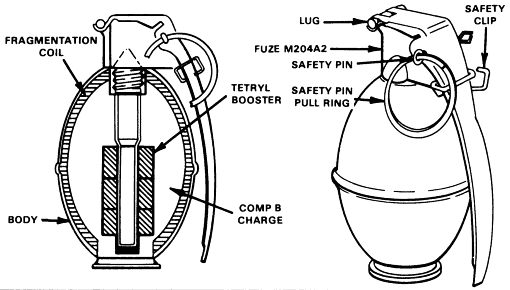
This type of grenade was developed to replace the earlier model fabricated with a deeply serrated cast iron body (the pineapple
World War I grenade).
Fragments are produced by a serrated wire coil fitted to the inside of the grenade body.
WARNING: Although the killing radius of this fragmentation grenade is 16 feet (5 m) and the casualty-producing radius is 50 feet
(15 m), fragmentation can disperse as far away as 755 feet (230 m).
The grenade is olive drab body with a single yellow band at the top. Nomenclature and or lot number markings are in yellow.
Grenade, Hand, Frag, Delay, M67
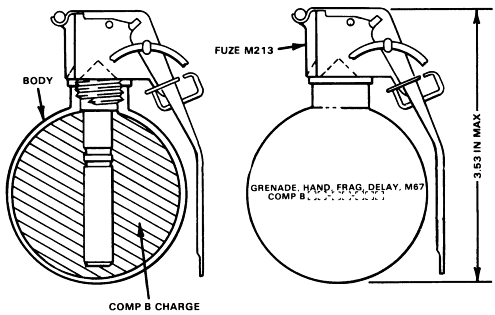
WARNING: Although the killing radius of this fragmentation grenade is 16 feet (5 m) and the casualty-producing radius is 50 feet
(15 m), fragmentation can disperse as far away as 755 feet (230 m).
The grenade has an olive drab body with a single-yellow band at the top. Markings are in yellow.
This is a training standard item used in both training and combat.
Type Classification Date: 1971. Unit cost: $27.64 (Fiscal Year 2005).
Grenade, Hand, Practice, M69
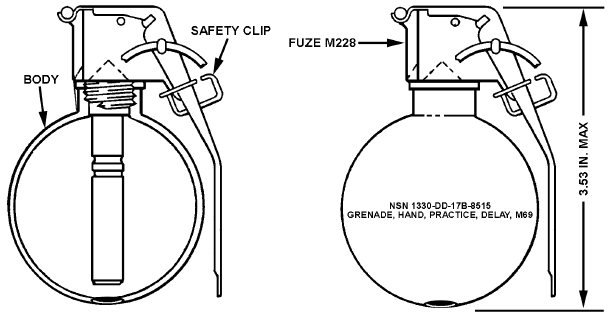
The M69 practice hand grenade simulates the M67 series of fragmentation hand grenades for training purposes. The grenade provides
realistic training and familiarizes the soldier with the functioning and characteristics of the fragmentation hand grenade.
After a delay of 4 to 5 seconds, the M69 emits a small puff of white smoke and makes a loud popping noise. The grenade body can be
used repeatedly by replacing the fuze assembly.
WARNING: Fuze fragments may exit the hole in the base of the grenade body and cause injuries.
The grenade is light blue with white markings. The safety lever of the fuze is light blue with black markings and a brown tip.
The M69 grenade has a safety clip.
Type Classification Date: 1971. Unit cost of body: $5.62 (Fiscal Year 2000/2001).
Grenade, Hand, Smoke, Tng, M83
The M83 training grenade is deployed in a similar manner as the M8 series of service smoke grenades. It can be used to screen
activities of small units and for ground-to-air signaling. The individual soldier in squad, company, and battalion units uses it.
This item is urgently required to replace the existing M8 hexachloroethane (HC) filled munition.
The M83 hand grenade contains approximately one pound of environmentally acceptable smoke mixture. The smoke mixture is initiated by
a pyrotechnic delay-igniting fuze. After initiation, there is a 3-second delay after which a dense smoke cloud of white smoke is produced.
This is a training unique item; not used in combat.
Type Classification Date: 1994. Unit cost: $35.49 (Fiscal Year 2005).
Grenade, Hand, Non-Lethal (Stun), M84
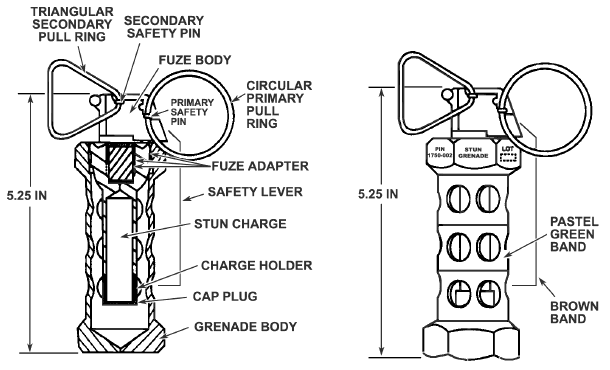
The M84 diversionary/flash-bang stun hand grenade is designed to be thrown into a room (through an open door, a
standard glass window, or other opening) where it delivers a loud bang (170 to 180 decibels at 5 feet) and bright
flash (1.5 to 2.5 million CP) sufficient to temporarily disorient personnel in the room.
WARNING: Do not practice "cook-off" with this grenade, since it has a short fuze delay time of 1.0 to 2.3 seconds.
CAUTION: Use stun grenades as field-expedient early warning devices only when in a combat environment.
Use of the M84 is not recommended for use in crowd control situations. Specialty teams, such as security response teams, and search teams may use this device effectively.
The body is a steel hexagon tube with 12 holes along the sides to allow for the emission of intense light and sound
when the grenade is ignited. The M84 also has a secondary safety pin with a triangular pull ring.
The grenade is olive drab with white markings, with a pastel green band on body and a brown band on safety lever
Unit cost: $150 (Fiscal Year 2006/2007).
Grenade, Hand, Fragmentation, MK2
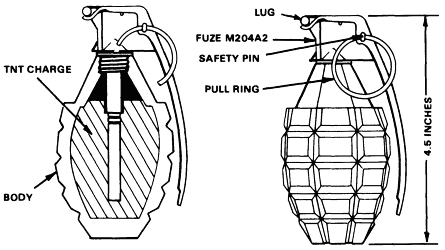
Obsolete. The MK2 is used to supplement small arms fire against the enemy in close combat. The grenade produces casualties by
high-velocity projection of fragments.
WARNING: If the fuze is loose, do not try to tighten it. This could set off the granular TNT in the grenade.
The grenade has an olive drab body with a single yellow band, which indicates a high-explosive filler.
Grenade, Hand, Offensive, MK3A2
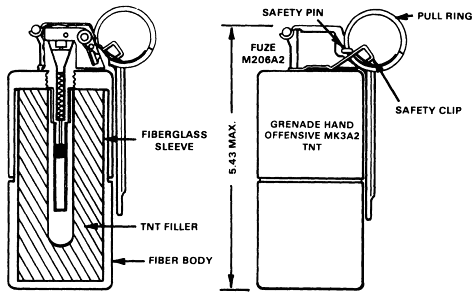
The MK3A2 offensive hand grenade, commonly referred to as the concussion grenade, is designed to produce casualties during close
combat while minimizing danger to friendly personnel. The grenade is also used for concussion effects in enclosed areas, for blasting,
and for demolition tasks. The shock waves (overpressure) produced by this grenade when used in enclosed areas are greater than those
produced by the fragmentation grenade. It is, therefore, very effective against enemy soldiers located in bunkers, buildings, and
fortified areas.
WARNING: The grenade has an effective casualty radius of 7 feet (2 m) in open areas, but secondary missiles and bits of fuze may be
projected as far as 656 feet (200 m) from the detonation point.
The grenade is black with yellow markings around its middle. The MK3A2 may be issued with or without a safety clip.
Grenade, No. 5, Mark I
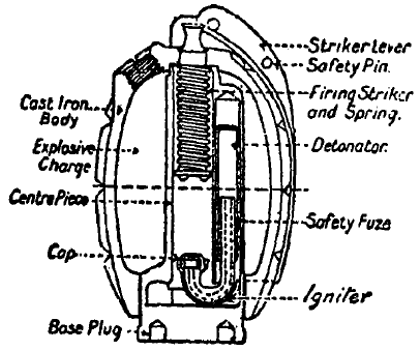
"Mills' Hand Grenade (Time)," "Mills grenade," "Mills bomb." Obsolete. WWI-era British grenade.
The body is cast iron, serated to provide fragments on detonation.
A center piece is screwed into one end with separate recesses for the striker and the detonator.
Mills grenades for use as rifle grenades (No. 23 Mills Rifle Grenade) must have solid, and not recessed, base plugs.
The striker is kept cocked against its spring by its head catching on the end of the striker lever when the latter is lying against the body of the grenade.
The lever is retained in this position by the safety pin.
The igniter is a separate unit, consisting of cap, cap chamber, safety fuse, and detonator (No. 6, which is is 1 3/8 inches long, No. 8 which is 2 1/8 inches).
The igniter is inserted into the grenade prior to use.
Note that if a fused grenade is not used, the igniter must be removed as soon as possible.
Under no circumstances should a fused grenade be returned to store.
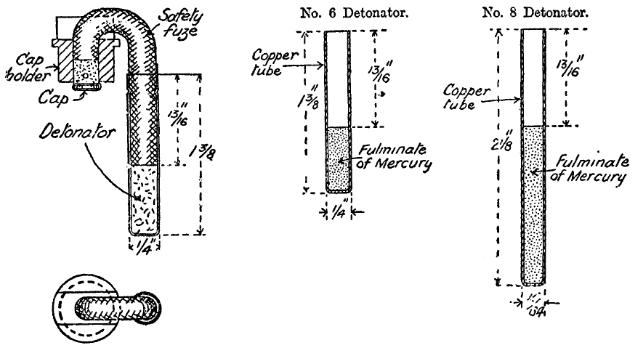
On withdrawal of the safety pin, the lever swings outward under the pull of the striker spring, thus releasing the striker which fires the cap.
The safety fuse burns about five seconds and then fires the detonator.
Mills grenades were packed 12 in a wooden box, with a cylinder containing 12 igniters.
Dummy igniter sets were supplied for the Mills grenade. They were distinguishable from the live sets by a hole,
about one-third of the diameter of the detonator in diameter, at the end of the detonator, and also by the cap having no central hole.
Dummy Mills training grenades were painted white.
Grenade, Hand, Practice, Non-Lethal (Stun), XM102
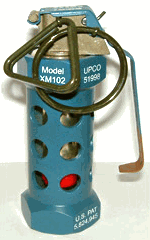
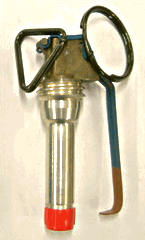
The XM102 Reloadable Stun Practice Hand Grenade (RSPHG) is the reloadable trainer for the M84 Stun Hand Grenade.
It offers realistic characteristics of the M84 to assist in the training of missions such as hostage rescue or capture
of criminals, terrorists or other adversaries.
The XM102 consists of a XM240 reloadable cartridge (Unit Cost: $92, FY 2006/2007) and an inert blue body.
Unit cost: $140 (Fiscal Year 2006/2007).
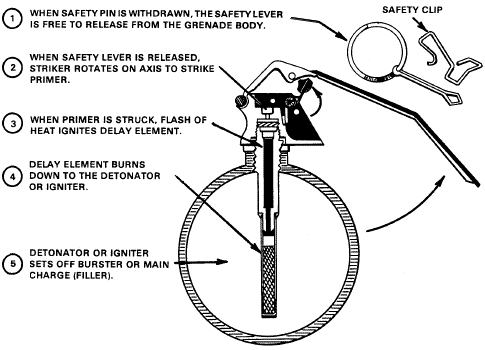
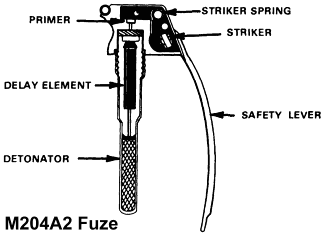
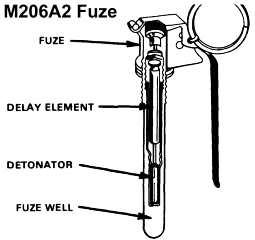

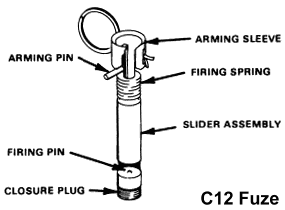
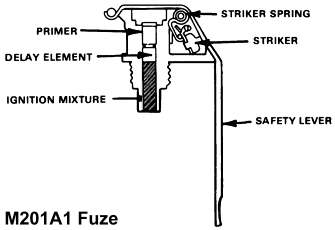
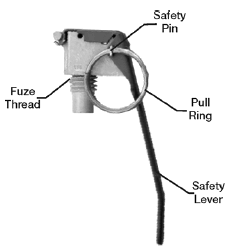
 The ABC-M7A2 and ABC-M7A3 riot-control hand grenades contain only CS as a filler. They differ only in the amount of filler and the
form of the CS they contain. The ABC-M7A2 grenade has 5.5 ounces of burning mixture and 3.5 ounces of CS in gelatin
capsules. The ABC-M7A3 has 7.5 ounces of burning mixture and 4.5 ounces of CS pellets.
The ABC-M7A2 and ABC-M7A3 riot-control hand grenades contain only CS as a filler. They differ only in the amount of filler and the
form of the CS they contain. The ABC-M7A2 grenade has 5.5 ounces of burning mixture and 3.5 ounces of CS in gelatin
capsules. The ABC-M7A3 has 7.5 ounces of burning mixture and 4.5 ounces of CS pellets.
 Obsolete. The ABC-M25A1 riot control hand grenade is a bursting munition with an integral fuze.
Obsolete. The ABC-M25A1 riot control hand grenade is a bursting munition with an integral fuze.


 The AN-M8 HC grenade is used to produce dense clouds of white smoke for signaling and screening. Note that this
grenade was listed as obsolete in the September 2000 FM 3-23.30, while the latest June 2005 release of the manual
lists the grenade as currently in service.
The AN-M8 HC grenade is used to produce dense clouds of white smoke for signaling and screening. Note that this
grenade was listed as obsolete in the September 2000 FM 3-23.30, while the latest June 2005 release of the manual
lists the grenade as currently in service.
 The AN-M14 TH3 incendiary hand grenade is used to destroy equipment or start fires. It can also damage, immobilize, or destroy
vehicles, weapons systems, shelters, or munitions.
The AN-M14 TH3 incendiary hand grenade is used to destroy equipment or start fires. It can also damage, immobilize, or destroy
vehicles, weapons systems, shelters, or munitions.
 The AN-M83 TA white smoke hand grenade is used for screening the activities of small units and for ground-to-air signaling.
The AN-M83 TA white smoke hand grenade is used for screening the activities of small units and for ground-to-air signaling.
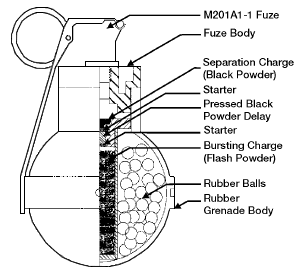
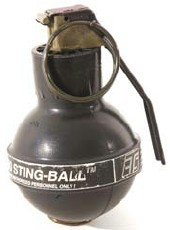
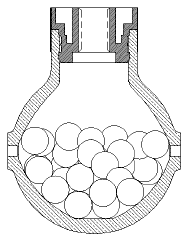
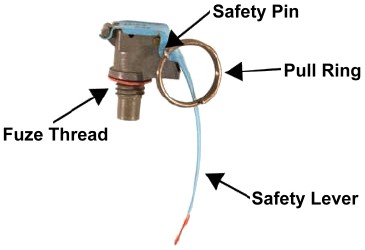
 The M15 white phosphorous grenade is a bursting type grenade used for signaling, screening, and incendiary purposes.
The M15 white phosphorous grenade is a bursting type grenade used for signaling, screening, and incendiary purposes.
 The M18 colored smoke hand grenade is used for ground-to-air or ground-to-ground signaling.
The M18 colored smoke hand grenade is used for ground-to-air or ground-to-ground signaling.
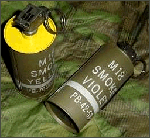
 Obsolete. These grenades are used to supplement small arms fire against an enemy in close combat. They produce casualties through
the high-velocity projection of fragments.
Obsolete. These grenades are used to supplement small arms fire against an enemy in close combat. They produce casualties through
the high-velocity projection of fragments.
 The M47 grenade is a special-purpose, burning type munition used for the control of riots and counterinsurgencies.
This grenade is a nonlethal, incapacitating type munition that contains non-persistent CS agent.
The M47 grenade is a special-purpose, burning type munition used for the control of riots and counterinsurgencies.
This grenade is a nonlethal, incapacitating type munition that contains non-persistent CS agent.
 This type of grenade was developed to replace the earlier model fabricated with a deeply serrated cast iron body (the pineapple
World War I grenade).
This type of grenade was developed to replace the earlier model fabricated with a deeply serrated cast iron body (the pineapple
World War I grenade).
 WARNING: Although the killing radius of this fragmentation grenade is 16 feet (5 m) and the casualty-producing radius is 50 feet
(15 m), fragmentation can disperse as far away as 755 feet (230 m).
WARNING: Although the killing radius of this fragmentation grenade is 16 feet (5 m) and the casualty-producing radius is 50 feet
(15 m), fragmentation can disperse as far away as 755 feet (230 m).
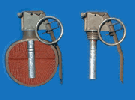
 The M69 practice hand grenade simulates the M67 series of fragmentation hand grenades for training purposes. The grenade provides
realistic training and familiarizes the soldier with the functioning and characteristics of the fragmentation hand grenade.
The M69 practice hand grenade simulates the M67 series of fragmentation hand grenades for training purposes. The grenade provides
realistic training and familiarizes the soldier with the functioning and characteristics of the fragmentation hand grenade.
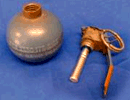
 The M84 diversionary/flash-bang stun hand grenade is designed to be thrown into a room (through an open door, a
standard glass window, or other opening) where it delivers a loud bang (170 to 180 decibels at 5 feet) and bright
flash (1.5 to 2.5 million CP) sufficient to temporarily disorient personnel in the room.
The M84 diversionary/flash-bang stun hand grenade is designed to be thrown into a room (through an open door, a
standard glass window, or other opening) where it delivers a loud bang (170 to 180 decibels at 5 feet) and bright
flash (1.5 to 2.5 million CP) sufficient to temporarily disorient personnel in the room.

 Obsolete. The MK2 is used to supplement small arms fire against the enemy in close combat. The grenade produces casualties by
high-velocity projection of fragments.
Obsolete. The MK2 is used to supplement small arms fire against the enemy in close combat. The grenade produces casualties by
high-velocity projection of fragments.
 The MK3A2 offensive hand grenade, commonly referred to as the concussion grenade, is designed to produce casualties during close
combat while minimizing danger to friendly personnel. The grenade is also used for concussion effects in enclosed areas, for blasting,
and for demolition tasks. The shock waves (overpressure) produced by this grenade when used in enclosed areas are greater than those
produced by the fragmentation grenade. It is, therefore, very effective against enemy soldiers located in bunkers, buildings, and
fortified areas.
The MK3A2 offensive hand grenade, commonly referred to as the concussion grenade, is designed to produce casualties during close
combat while minimizing danger to friendly personnel. The grenade is also used for concussion effects in enclosed areas, for blasting,
and for demolition tasks. The shock waves (overpressure) produced by this grenade when used in enclosed areas are greater than those
produced by the fragmentation grenade. It is, therefore, very effective against enemy soldiers located in bunkers, buildings, and
fortified areas.
 "Mills' Hand Grenade (Time)," "Mills grenade," "Mills bomb." Obsolete. WWI-era British grenade.
"Mills' Hand Grenade (Time)," "Mills grenade," "Mills bomb." Obsolete. WWI-era British grenade.



 The XM102 Reloadable Stun Practice Hand Grenade (RSPHG) is the reloadable trainer for the M84 Stun Hand Grenade.
It offers realistic characteristics of the M84 to assist in the training of missions such as hostage rescue or capture
of criminals, terrorists or other adversaries.
The XM102 Reloadable Stun Practice Hand Grenade (RSPHG) is the reloadable trainer for the M84 Stun Hand Grenade.
It offers realistic characteristics of the M84 to assist in the training of missions such as hostage rescue or capture
of criminals, terrorists or other adversaries.